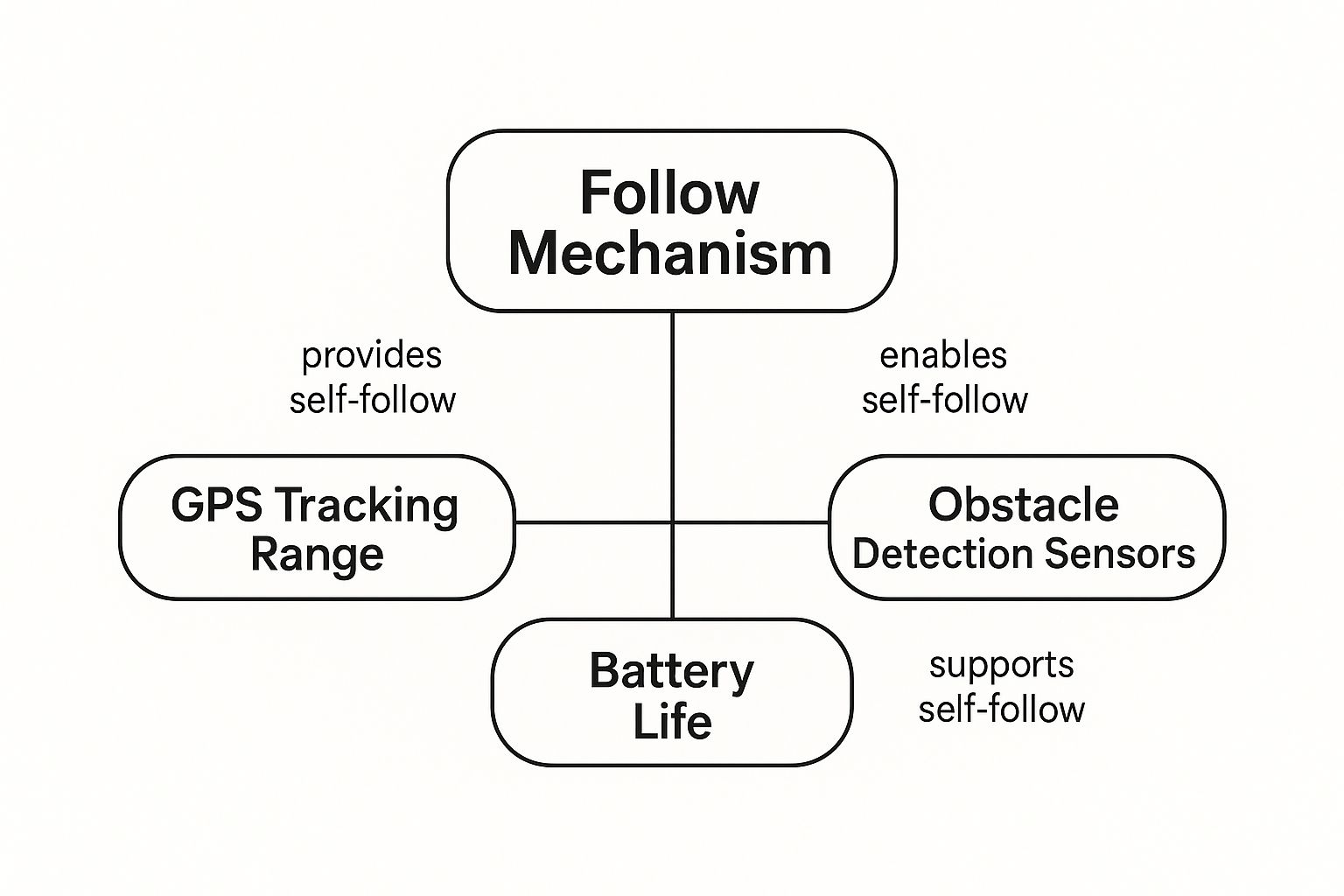Picture this: you're walking down the fairway, totally dialed in on your next shot, and your clubs are just… there with you. Not on your back, not something you’re pushing, but gliding along silently behind you like a seasoned caddie. This isn't some futuristic fantasy—it's the reality of golf carts that follow you, and they’re changing the walking golfer’s experience for the better.
The Rise of the Hands-Free Golfing Experience

Think of it as your personal golf assistant, one that knows exactly where you’re going without you having to say a word. That’s the simple idea behind a self-following golf cart. It’s way more than just a set of wheels; it's an automated partner built to carry your gear, so you can walk the course unburdened and keep your head in the game.
This hands-free approach is completely reshaping how people enjoy a round of golf, blending the physical benefits of walking with some seriously cool tech. It's not just a niche gadget, either. This technology is a big reason the global golf cart market, valued at over USD 2.3 billion in 2025, is expected to climb to USD 4 billion by 2034. You can dig deeper into the market trends and their driving factors here.
What Defines an Autonomous Golf Cart
So, how does it actually work? At its core, a follow-me golf cart uses a mix of sensors and a small remote you keep with you. This combo allows the cart to lock onto your position and trail you down the fairway, always keeping a safe distance. It’s a huge departure from a traditional cart that needs someone behind the wheel.
Golfers are flocking to them for a few key reasons:
- Better Focus: Without the stop-and-start of driving a cart, you can stay in your mental flow state, thinking about your next shot without interruption.
- Less Fatigue: Walking the course is fantastic exercise, but lugging a bag or even pushing a cart can wear you down by the back nine. An autonomous cart takes that strain away completely.
- Improved Pace of Play: The cart moves when you move. There’s no more time wasted walking back to a parked push cart or getting in and out of a traditional one.
To help you see the difference clearly, here's a quick breakdown.
Autonomous vs Traditional Golf Carts At a Glance
This table provides a quick comparison of the key differences between traditional golf carts and modern autonomous models.
| Feature | Traditional Golf Cart | Follow-Me Golf Cart |
|---|---|---|
| Operation | Requires a driver to steer and operate | Follows the user automatically via remote/sensor |
| Physical Effort | Low (sitting), but involves driving tasks | Minimal; allows for walking without carrying clubs |
| Focus on Game | Can be distracting (driving, parking) | High; enables full concentration on the round |
| Pace of Play | Can be slow due to stop-start nature | Generally faster and more consistent |
| Cost | Varies, but can be a significant investment | Typically a premium price point |
| Primary Use | Transporting 2-4 players and bags | Carrying one player's bag, allowing them to walk |
As you can see, the autonomous cart is purpose-built to enhance the walking golfer's experience, prioritizing focus and freedom over simple transportation.
More Than Just a Golf Accessory
While they made their name on the golf course, these clever carts are finding new homes far beyond the 18th hole. Think about sprawling resorts, large corporate campuses, and even big residential communities.
Their quiet, all-electric operation and automated convenience make them a fantastic solution for getting around large properties without having to hop in a car.
The real magic is how seamlessly it fits into your walk. The cart is just there when you need it and out of mind when you don't. It fundamentally changes the dynamic between you and your equipment.
How These Autonomous Carts Actually Work
Watching your golf cart shadow you down the fairway might feel like magic at first. But what’s really happening is a smart combination of hardware and software working together seamlessly. The best way to think about it is like a high-tech robotic vacuum cleaner, but instead of mapping out your living room, it’s locking onto your position on the course.
The whole system is built around one simple idea: creating a reliable digital tether between you and your cart. This is usually done with a small remote you can clip on your belt or a simple smartphone app. This device acts like a beacon, constantly sending out a signal that tells the cart, "Hey, I'm over here!" The cart’s job is to follow that signal while maintaining a safe, consistent distance.
This infographic breaks down the core components that make it all possible.

As you can see, it’s the constant communication between tracking, sensing, and power systems that allows these carts to operate so smoothly.
The Cart’s Senses
For that digital tether to work without a hitch, the cart has to "see" what’s around it. This is where a whole suite of advanced sensors comes into play. These are the cart’s eyes and ears, constantly scanning the environment for anything that could get in the way—be it a tree, a bunker, or another golfer.
- Cameras: These give the cart visual data, helping it recognize different types of terrain and identify obstacles ahead.
- LIDAR (Light Detection and Ranging): This is the cool part. LIDAR uses laser pulses to build a 3D map of the area, giving it super-accurate distance measurements to everything around it.
- Ultrasonic Sensors: Perfect for close-quarters maneuvering, these sensors detect nearby objects to prevent little bumps and scrapes in tight spots.
All of this information gets fed into the cart's onboard computer—its brain. This processor crunches thousands of calculations every second to adjust the speed, steering, and braking in real-time, making sure your journey is always safe and smooth.
The real genius is in the sensor fusion. The cart doesn't just rely on one input; it combines data from cameras, LIDAR, and other sensors to build a complete, accurate picture of its environment, much like a person uses multiple senses to navigate a room.
The Power and Brains Behind the Movement
This complex network of sensors and processors needs a steady, reliable power source to keep everything running. The technology behind golf carts that follow you has come a long way, thanks mostly to advancements in battery tech. Modern lithium-ion batteries are a game-changer, offering much better range and quicker charging times than the old lead-acid ones.
On top of that, the integration of IoT and GPS systems allows for the kind of precise tracking and navigation that's essential for safe autonomous movement. If you want to dive deeper, you can learn more about the technology driving the golf cart market.
At its core, the cart’s brain is processing a constant stream of information. It gets the "follow me" command from your remote, checks that against all the data coming in from its obstacle avoidance sensors, and then sends exact instructions to the electric motor and steering system.
It’s a continuous loop: sense, think, and act. The cart sees a tree up ahead, calculates a path to go around it, and does all this while keeping its main focus on staying the perfect distance from you. This frees you up to walk the course unburdened, knowing your clubs are right there with you, ready for the next shot.
What Are the Real Perks of a Follow-Me Golf Cart?

Sure, the cool factor of having your clubs trail you like a loyal caddie is a big part of the appeal. But the real reason so many golfers are switching to golf carts that follow you comes down to the practical, game-changing advantages. These benefits go way beyond novelty—they directly impact your focus, your energy, and even your scorecard.
The biggest win? A huge boost in mental focus. Golf is all about concentration, and the stop-and-go routine of a regular cart—drive, park, walk to your ball, walk back—shatters your rhythm. A self-following cart cuts out all that noise. It lets you walk the fairway and stay completely dialed in on your next shot, just like the pros.
This hands-free approach creates a smoother, more natural flow to your game. Your cart moves when you move, so your clubs are always right there when you need them. No more wasted time or energy, just a steady, uninterrupted pace of play.
Better Performance, Less Fatigue
Walking a golf course is fantastic exercise, but lugging a heavy bag for 18 holes can be brutal. That physical strain, especially on the back nine, is a recipe for sloppy swings and bad decisions. A follow-me cart takes that weight off your shoulders without forcing you into a seat.
By ditching the physical burden, you save your energy for what actually matters: your swing. Countless golfers report feeling fresher and more mentally sharp at the end of a round, which often translates directly into lower scores.
The most common feedback we hear from users is that they can finally walk the course and get the exercise they want, without paying the price in aches and pains. It’s the perfect middle ground—you’re not riding, but you’re not carrying, either.
This blend of convenience and light exercise makes the game more enjoyable and accessible for a much wider range of players.
Greater Accessibility and On-Course Safety
These carts are also a game-changer for players with mobility challenges. If pushing a cart or climbing in and out of a traditional one is difficult, the automated assistance makes walking the course a real possibility again. It opens up the game for more people to enjoy.
On top of that, safety is built right into their design. These carts are packed with smart collision avoidance systems that let them navigate around obstacles like trees, bunkers, or other golfers. Automated braking keeps them at a safe following distance, so you never have to worry about it running into you.
- Laser Focus: Keep your mind on the game, not on your gear.
- Less Physical Toll: Walk 18 holes and still feel strong on the final green.
- Smarter Pace of Play: No more time wasted trekking back and forth to a parked cart.
- More Accessible Golf: Makes walking the course a viable option for a wider range of players.
Deciding on the right model means weighing these benefits against the features and costs. For a deeper look, you can learn more by finding the best follow-me golf cart for your game in our complete guide. At the end of the day, it's just a smarter way to play.
Choosing Between Integrated Carts And Upgrade Kits
When you decide it’s time for a golf cart that follows you, you’re looking at two main paths. You can either spring for a brand-new cart with the autonomous tech already built-in, or you can grab an aftermarket kit to upgrade the trusty cart you already own.
Each route has its own pros and cons, boiling the decision down to your budget, how much convenience you’re after, and whether you're comfortable with a little hands-on work.
An integrated cart is the all-in-one, ready-to-go solution. Think of it like buying a new car with all the modern tech factory-installed. Everything is designed to work together from the get-go, giving you a polished, seamless experience right off the lot.
On the other hand, an upgrade kit is like adding a powerful new engine to a car you already love. It's often a more wallet-friendly approach that lets you stick with the cart you know, but it might require some installation and a bit of tweaking to get everything humming just right.
The All-in-One Factory Model
Going with a factory-integrated model means you're investing in a complete, cohesive package. Big names like Club Car and E-Z-GO have poured a ton of resources into designing carts where the follow-me technology is literally part of the vehicle's DNA.
This approach brings some serious advantages to the table:
- Seamless Performance: The software and hardware were made for each other, which means smoother operation and fewer frustrating glitches.
- Full Warranty Coverage: The entire cart, follow-me system included, is covered under a single manufacturer's warranty. That makes any potential service needs a whole lot simpler.
- Polished User Experience: From the remote to the display, every little detail is designed for intuitive, hassle-free use from the moment you unbox it.
The biggest hurdle here is the cost. A brand-new autonomous cart is a significant investment, often running thousands more than its non-autonomous cousin.
The real value of an integrated model is its plug-and-play simplicity. There’s no guesswork—you just charge it up, hit the course, and enjoy a flawless hands-free round.
The Flexible Aftermarket Upgrade
If you already have a push cart or a basic electric cart that you’re perfectly happy with, an aftermarket conversion kit is a fantastic alternative. These kits give you all the necessary motors, sensors, and control units to bring autonomous capabilities to your current ride. This path is especially popular for its cost savings and flexibility.
The main draw is the price—you're only paying for the tech, not an entirely new vehicle, which can save you a bundle. Plus, a lot of golfers find the DIY aspect pretty rewarding. Kits like these are often designed for a pretty straightforward installation, letting you transform your current cart in a short amount of time.
If you're starting with a smaller push cart, you can learn more about this approach in our guide on electric push cart conversion kits, a green alternative for golf enthusiasts.
Of course, this route means you have to do your homework on compatibility. You need to be sure the kit you choose is made to work with your specific cart model. While many are versatile, they aren't all universal.
Factory-Integrated vs Aftermarket Kits
So, which path is right for you? It really comes down to your priorities—are you looking for a ready-made premium experience, or do you prefer a budget-friendly DIY project? This table breaks down the key differences to help you decide.
| Aspect | Factory-Integrated Models | Aftermarket Conversion Kits |
|---|---|---|
| Initial Cost | High | Low to Moderate |
| Performance | Seamless and highly reliable | Good, but may require tuning |
| Installation | None required | DIY or professional installation needed |
| Warranty | Comprehensive manufacturer warranty | Separate warranty for the kit only |
| Convenience | Ready to use immediately | Requires setup and compatibility checks |
Ultimately, there’s no single "best" answer—just the best choice for your situation. If you value flawless performance and ultimate convenience right out of the box, an integrated model is tough to beat. But if you’re looking to save some cash and don't mind a little setup, an aftermarket kit can give your current cart an incredible new lease on life.
What to Consider Before You Buy

Alright, so you're sold on the idea of a golf cart that follows you. It’s a big decision, and it’s easy to get wowed by the cool factor. But to find the right fit, you have to look past the initial sticker price.
Before you pull the trigger, there are a few core features that will make or break your experience on the course. Think of it less like buying a new gadget and more like picking a reliable caddie for every round you play.
First up, and arguably the most critical piece of the puzzle, is battery life and range. A cart that dies on you at the 14th hole is worse than useless—it’s a dead weight you have to lug around. Look for models with modern lithium-ion batteries. They tend to have a longer lifespan, charge up way faster, and can often cover a full 36 holes on a single charge. That’s a huge step up from the older, clunkier lead-acid batteries.
Terrain Handling and Sensor Smarts
Let's be real: not every golf course is a perfectly flat, manicured paradise. Your cart's ability to handle the real world—from steep, grassy hills to damp fairways—is a make-or-break feature.
Check the motor power and wheel design to make sure it can climb inclines without sounding like it's about to give up. A powerful motor is what gives you consistent performance, no matter how challenging your home course gets.
Just as important is the "smarts" of the sensor system. The cart’s whole job is to follow you without running into trees, taking a detour into a sand trap, or getting uncomfortably close. This all comes down to its sensors. A system with a solid combination of cameras, LIDAR, and ultrasonic sensors is going to give you the most dependable, hands-off experience.
The true test of a great autonomous cart isn't just following you on an open fairway; it's how intelligently it handles the unexpected obstacles and challenging slopes that every course presents.
Usability and Long-Term Ownership
Beyond the high-tech stuff, you need to think about the day-to-day practicalities. How intuitive is the remote control? A simple, user-friendly remote should feel like second nature, letting you focus on your next shot, not on fiddling with buttons.
Also, consider what long-term ownership looks like. What are the maintenance requirements? Does the manufacturer offer software updates? Those updates can be a big deal, sometimes adding new features and improving performance over time.
Finally, do the math on the total cost of ownership. This isn't just the purchase price. Factor in potential maintenance, the cost of a replacement battery down the line, and any subscription fees for premium features.
For some golfers, a good middle ground is motorizing the push cart they already own. If that sounds more your speed, our guide explains how to convert a push cart to electric with an easy DIY guide.
These autonomous carts are catching on fast, especially with younger players and even in urban planning for short-distance transport. Pilot programs are popping up all over the world. You can discover more insights about the rising demand for autonomous carts on GlobeNewswire.
By carefully weighing these factors, you can be confident you’re choosing one of the golf carts that follow you that will truly elevate your game.
Frequently Asked Questions
Jumping into the world of autonomous golf technology naturally brings up a few questions. Before you invest, you want to be confident that these smart carts can handle real-world situations out on the course. We've gathered the most common queries about the safety, reliability, and rules for golf carts that follow you.
How Does The Cart Avoid Obstacles?
This is usually the first thing people ask, and for good reason. Nobody wants their brand-new cart taking a detour into a water hazard, a bunker, or another golfer. The good news is these carts are loaded with a sophisticated sensor system designed to prevent exactly that.
Think of it as a multi-layered bubble of awareness.
- Primary Sensors (LIDAR/Cameras): These are the cart's eyes for seeing the big picture. They constantly scan ahead for large obstacles like trees, other carts, and sand traps, allowing the cart’s brain to chart a safe path around them.
- Secondary Sensors (Ultrasonic): For everything up close, ultrasonic sensors work like the parking sensors in your car. They pick up on things the main sensors might overlook, like a stray golf bag or a low-hanging tree branch, preventing those minor bumps and scrapes.
By combining these technologies, the cart builds a constant 3D map of its surroundings. It makes smart, real-time decisions to navigate safely and is programmed to be cautious, always choosing a clear path over the quickest one.
What Happens If The Remote Dies Or Loses Connection?
A dead battery or a lost signal is another common worry. What stops the cart from blindly continuing on its last command and rolling straight into trouble? Every reputable follow-me system is built with failsafe protocols to handle this exact scenario.
The moment that digital link between your remote and the cart is broken, the cart’s default command is to stop immediately. It won't keep rolling or try to guess where you've gone. The system is designed to freeze in place and simply wait for the connection to be restored.
This automatic braking is a non-negotiable safety feature. The cart is programmed to know that a lost signal is an unknown situation, and the safest response is always to stop and wait for you to take back control.
Once you pop a new battery in the remote or walk back into range, the connection syncs up, and you can get back to your round without missing a beat.
Are There Course Restrictions For Follow Carts?
While these carts are built for the golf course, the final say always comes down to the individual club. Most courses are embracing this technology, especially since it helps speed up play and gives walking golfers a fantastic experience. That said, some private or more traditional clubs might have their own specific rules.
It’s always a good idea to check with the pro shop before bringing your autonomous cart to a new course for the first time. A quick call is all it takes to clear things up. Generally, as long as the cart is used responsibly and doesn't harm the turf, most courses are happy to have them. As the popularity of golf carts that follow you grows, more and more facilities are getting familiar with their safe and efficient operation.
Ready to transform your walk on the course? The Caddie Wheel offers a simple, powerful, and affordable way to upgrade your existing push cart with remote-controlled power. Experience the freedom of a hands-free round and save your energy for the game. Explore the Caddie Wheel today!


Share:
How Many Calories Burned Golfing Your Guide
Effective Golf Course Management Strategies to Boost Your Club